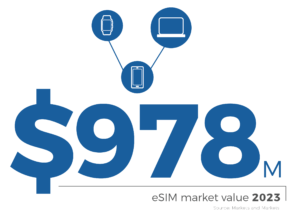
Stéphane Fund, Group CEO
A major breakthrough in the world of mobile communications took place just a year ago when Apple announced its new product range in September of 2018 with an eSIM-enabled iPhone, Apple Watch, and iPad. This came after years of talk about the next-generation SIM and the standardisation of its ecosystem. It was a signal to all stakeholders — mobile network operators, chip manufacturers, device and subscription managers — that in order to provide a better, more seamless, and flexible service to subscribers, it was time to evolve from the 30-year-old detachable plastic SIM to a new digital reality. This week, Samsung, the world’s largest mobile phone producer joined the party with a range of their first eSIM-enabled smartphones.
So are operators ready to capitalise on eSIM?
As well as the attractiveness to the customer of increased flexibility and freedom, eSIMs solve a lot of distribution issues for operators — they no longer have to support a complex, expensive and slow network of distributors. Some dynamic operators have quickly jumped on the opportunity and already announced new digital offers. At the time of writing, Apple lists around 120 network operators (Orange, AT&T, EE, Etisalat, Airtel, etc.) across over 50 countries catering to subscribers using this technology. And with the total number of eSIM devices surpassing 280 million in 2019 and rising, operators continue to be more and more aggressive in their promotion of the new capabilities brought about by this never-seen-before digital connectivity offering. This has allowed many to win new market share and increase revenue.

Vodafone’s V series range of device subscriptions
Since eSIMs are nearly 90 times smaller, rugged and can be remotely managed, the chip lends itself to connecting a wide range of devices beyond the traditional mobile phone; including watches, laptops, trackers, and cars like what Vodafone has done with its V series product range. This enables operators to offer new services to their existing subscriber base, therefore, increasing their ARPU.
eSIM is also a digital disruptor, with MasMovil, reportedly utilising it to become the fastest-growing operator in Europe gaining market share through smartphone and watch subscriptions.
Where are device manufacturers in the eSIM adoption process?
Besides Apple, Android manufacturers have also launched devices with this next-generation technology. These include Samsung with the latest Galaxy range, Z Flip and Gear watches, Google with its Pixel series, Huawei with its Watch 2, and Xiaomi with its Mi MIX Alpha. Perhaps most notably, Motorola recently introduced its Moto Razr, which goes a step further in this SIM evolution process offering no detachable SIM at all, making it the first-ever eSIM-only phone.
As of now, not all handsets and wearable devices support eSIM technology yet, it is only a matter of time before more of these devices adopt it, leading to the eventual elimination of the physical SIM card altogether. According to analysts, high-ARPU customers, typically the owners of high-end Apple or Android eSIM devices are the first ones to switch and activate digital subscriptions with telecom operators. Most expect that as more manufacturers of Android devices introduce eSIM connectivity, the market will see a real transition with hyper-adoption of the new digital SIM.
According to Markets and Markets, this will lead the global eSIM market to grow from US$ 254 million in 2018 to US$ 978 million by 2023. eSIM connectivity will enable greater involvement of all players in the ecosystem and, the launch of multi-device offers from operators that will represent an essential added value for consumers. The ecosystem will evolve with providers of remote SIM provisioning services, which are instrumental in giving mobile network operators the flexibility they need to remotely manage subscriptions and new services.
What are we waiting for?
Even as this market shows signs of strong growth, one may wonder why it is not taking off faster, particularly, given most analysts have been projecting hyper-adoption for the last two years. Well, as with most new technologies that promise revolution, perhaps once again, reality has been blurred by the hype and the promise of the ground-breaking new benefits. It’s not the first technology to fall victim to this and it will certainly not be the last. From what we see currently in the market, eSIM adoption is rather more progressive than revolutionary, nevertheless, its growth curve is still highly impressive. Its ecosystem is instrumental to its development and this is why we see it taking a bit longer with the key players such as mobile network operators, device vendors, and regulators, a bit slower to adopt the new technology than originally anticipated.

Some of the eSIM devices in the market. Top row L-R: Samsung Galaxy Z Flip, iPhone 11 Pro Max, Samsung Gear S2. Second row L-R: Land Rover Defender, Microsoft Surface Pro, Deloitte Smart Helmet Clip
The future for eSIM
Now, with more manufacturers including this technology in their new devices and the positive results obtained by those operators first to move into eSIM, things are expected to heat up further in the coming months. Apple and Samsung are the first and biggest dominos to fall in a line of global device manufacturers. Perhaps an increase in the number of lower-budget eSIM-enabled devices is still needed to give this opportunity wider appeal across all customer segments, but this is surely just a matter of time. The market is evolving quickly and so is the opportunity for manufacturers and operators. As a recognised and certified market leader in this technology, Workz helps operators, OEMs, and integrators digitise their customer journey with full support on all elements of the eSIM lifecycle from secure data management, production and personalisation, to profile development and remote SIM provisioning services. We provide a quick and easy setup which allows you to establish that all-important early foothold in this new market. If you’re interested in learning more, then drop me a message here.



